Home / Bonus Topic: Allylic Rearrangements
Free Radical Reactions
Bonus Topic: Allylic Rearrangements
Last updated: July 31st, 2025 |
Allylic Rearrangements – Allylic Bromination With Rearrangement
- In allylic bromination reactions, the C-H bond of an allylic carbon breaks, and a new C-Br bond is formed.
- This reaction sometimes occurs with allylic rearrangement. That is, the new C-Br bond forms on the end carbon of the pi-bond, and the pi bond moves over such that the original sp3-hybridized C-H carbon becomes an alkenyl carbon.
- This can be favored in cases where a more substituted double bond results (i.e. Zaitsev’s rule)
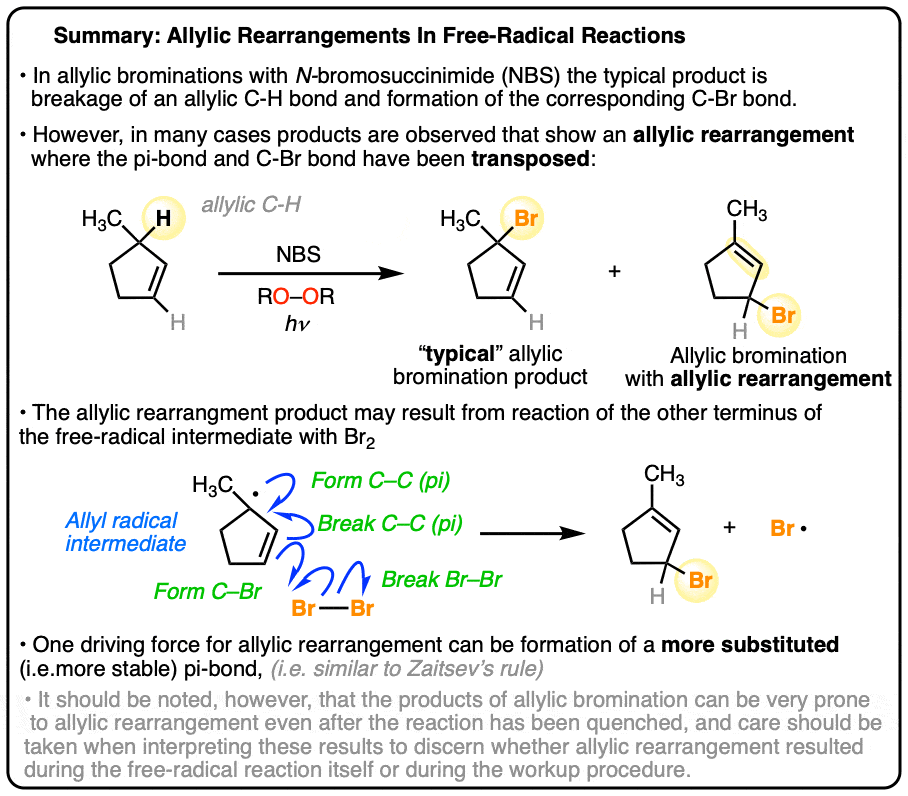
- Note – in the real world, given how sensitive allylic bromides can be to rearrangement all on their own, it’s important to distinguish whether or not the allylic rearrangement occurred during the free-radical reaction itself or during the workup procedure. See this reference for a great example.
Table of Contents
- An Allylic Bromination That Gives Two Products
- “Product B” Is An Example Of Allylic Bromination Accompanied By Allylic Rearrangement
- Why Might “Product B” Be Favored Here? Remember Zaitsev’s Rule!
- Notes
- (Advanced) References and Further Reading
1. An Allylic Bromination That Gives Two Products
Today’s topic flows right from the subject of the last post, on allylic bromination. It’s on allylic bromination reactions that happen with a rearrangements.
In the last post on allylic bromination, the examples used were actually quite simple.
For example, if you take cyclopentene and treat with NBS and light (hv) in carbon tetrachloride solvent (CCl4), you get this product:
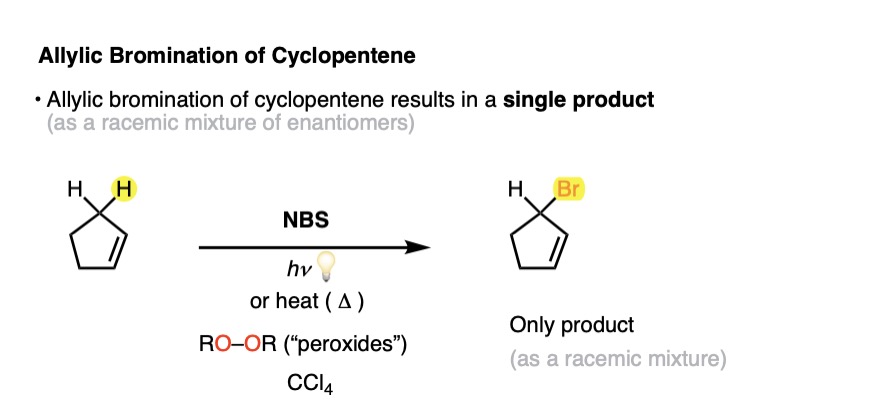
There’s no other possibility.
Now let’s extend the complexity of the substrate a little bit. Just replace one of the C–H bonds with a C–CH3 bond, and do the exact same reaction.
Here, we get not one product, but two. And note how our major product is different!
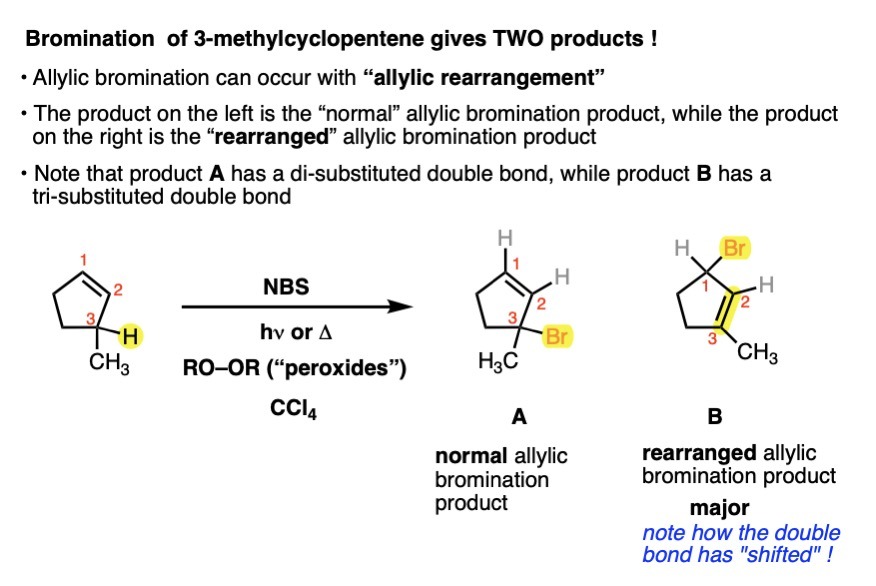
What’s going on here?
2. “Product B” Is An Example Of Allylic Bromination Accompanied By Allylic Rearrangement
Let’s think about the mechanism of this reaction. What’s the first thing to happen (after initiation, of course)?
Removal of the weakest C-H bond by the bromine radical! This leaves us with an allylic radical, which can then react with Br2 to give us product A.
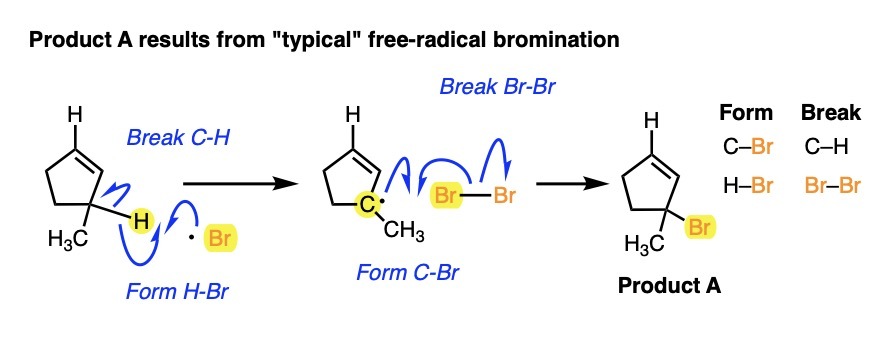
Simple enough. But how do we explain the formation of product B?
Look again at the free radical that is produced. Notice anything special about it?
We can draw a resonance form!
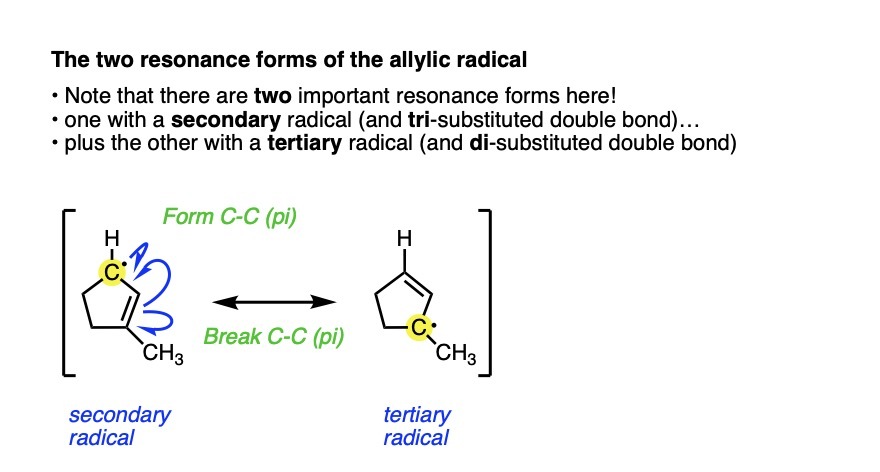
This means that there are two carbons on this molecule which can potentially participate in free radical reactions. Therefore we can also draw a reaction mechanism which shows Br2 reacting at this bottom (tertiary) carbon:
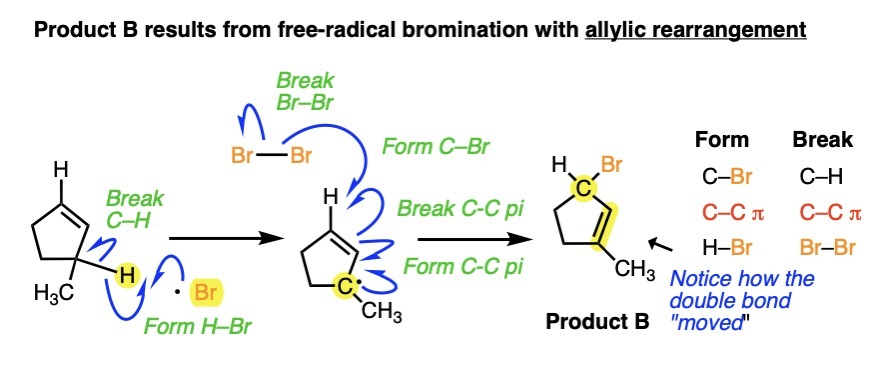
See how the tertiary radical forms a new π bond while the other π bond breaks? This leaves one of the electrons of the “top” alkene to form a new bond with bromine, giving us a new C-Br bond.
If you analyze the bonds that form and break in this reaction (always a useful exercise), note that this reaction has an extra pair of events – one C-C π bond breaks, and one C-C π bond forms.
The net effect is that it looks like the π bond has moved. This phenomenon is called “allylic rearrangement“.
Note: as commenter Keith helpfully points out, remember that resonance forms are “hybrids”. When drawing the mechanism, it’s best to show it all happening in one step (as in the middle drawing, above) rather than to draw the resonance form and then draw bromination.
3. Why Might “Product B” Be Favored Here? Remember Zaitsev’s Rule!
Last question. Can you think of a reason why product B might be more favoured, especially under conditions of high temperature?
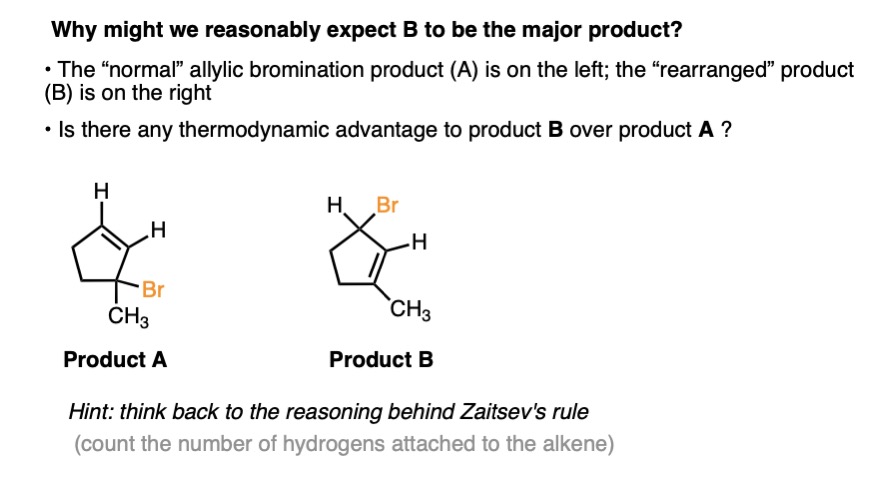
Think back to Zaitsev’s rule (if you’ve covered this) : the more substituted an alkene is, the more stable it is. (See article – Stability of Alkenes)
(why? the reason is complex and usually not covered in introductory textbooks – it has to do with a phenomenon called “hyperconjugation”) .
The alkene in product A is what we’d call “di-substituted” – it is directly attached to two carbon atoms and two hydrogen atoms. The alkene in product B is “trisubstituted” – it is directly attached to three carbon atoms and one hydrogen atom. Therefore there is good reason to expect that product B will be a significant product in this case.
[I’m hedging on the exact ratio because I don’t have a literature reference. You shouldn’t completely believe me without firm data from a literature reference; I’ll try to dig one up].
Next Post: Free Radical Addition Of HBr To Alkenes
Notes
Related Articles
(Advanced) References and Further Reading
- Brominations with N-Bromosuccinimide and Related Compounds. The Wohl-Ziegler Reaction.
Carl Djerassi
Chemical Reviews 1948, 43 (2), 271-317
DOI: 1021/cr60135a004
An old review by noted chemist Carl Djerassi, whose major contribution to global health was the development of norethindrone – the first female contraceptive. This review contains several examples of allylic systems that rearrange under free-radical conditions (bromination with NBS). - Substitution And Rearrangement Reactions Of Allylic Compounds
R. H. DeWolfe and W. G. Young
Chemical Reviews 1956, 56 (4), 753-901
DOI: 10.1021/cr50010a002
This early review mentions free-radical allylic rearrangements briefly – see pg. 761. Prof. W. G. Young helped build up the UCLA department of chemistry to what it is today, and there is a building named after him on the UCLA campus. - Cyclic Polyolefins. II. Synthesis of Cycloöctatetraene from Chloroprene
Arthur C. Cope and William J. Bailey
Journal of the American Chemical Society 1948, 70 (7), 2305-2309
DOI: 1021/ja01187a002
An early paper by Prof. Arthur C. Cope (of Cope rearrangement fame, and now the eponymous ACS Cope Scholar Award) on the synthesis of cyclooctatetraene. One of the steps involves bromination of 1,5-cyclooctadiene with NBS, which gives a monobromo compound. Cope mentions that they did not ascertain the exact location of the Br in the product and that 2 possible compounds can be formed (IIIa and IIIb), due to rearrangement. - THE PEROXIDE EFFECT IN THE ADDITION OF REAGENTS TO UNSATURATED COMPOUNDS. XIII. THE ADDITION OF HYDROGEN BROMIDE TO BUTADIENE
M. S. KHARASCH, ELLY T. MARGOLIS, and FRANK R. MAYO
The Journal of Organic Chemistry 1936, 01 (4), 393-404
DOI: 10.1021/jo01233a008
Another early paper by M. S. Kharasch in which he studies the addition of HBr to butadiene, in which he attempts to rigorously separate the two modes of addition – electrophilic vs. radical. There is an example of an ‘allylic rearrangement’ here – Prof. Kharasch shows that reaction of 3-bromo-1-butene with HBr under free-radical conditions (peroxides) can give 1,3-dibromobutane. This would be obtained via the intermediate allyl radical, which can add a bromine radical at either the 1- or 3- position. - Cyclobutane Derivatives. IV. Ziegler Bromination of Methylenecyclobutane
Edwin R. Buchman and David R. Howton
Journal of the American Chemical Society 1948, 70 (7), 2517-2520
DOI: 1021/ja01187a063
Ziegler reaction of methylenecyclobutane gives a mixture of “normal” and rearranged allylic bromination products (normal dominates). - CYCLOHEXENE-3,3,6,6-d4 A USEFUL COMPOUND FOR THE STUDY OF MECHANISM AND STRUCTURE
Saul Wolfe and P. G. C. Campbell
Can. J. Chem. 1965, 43 (5), 1184-1198
DOI: 10.1139/v65-156
Allylic bromides can easily undergo rearrangement – while the initial “normal” product might be formed in the reaction mixture, workup can often lead to scrambling. This study found that allylic bromination occurred “normally” but upon workup, rearrangement occurred to give the isomeric allyl bromide. - The Reaction of N-Bromosuccinimide with 2-Heptene
Fred L. Greenwood and Morton D. Kellert
Journal of the American Chemical Society 1953 75 (19), 4842-4843
DOI: 10.1021/ja01115a514
This study set out to test if allylic bromination would result in bromination of the methyl or the methylene position of 2-heptene. The result was a 58-64% yield of 4-bromo-2-heptene as the major product (See Org. Syn. 1958, 38, 8) with no observed bromination of the methyl position. It should be noted that this study predates NMR – a more modern study would probably show bromination of the methyl group as a minor product.
Indeed, a recent (2024) investigation at Winona State University in Minnesota by Devann J. Harris and Bryanna L. Wichner found that bromination of trans-2-hexene gave 4-bromo-2-hexene (50% by GC-MS) followed by the rearrangement product 2-bromo-3-hexene (32%) and several minor products.
00 General Chemistry Review
01 Bonding, Structure, and Resonance
- How Do We Know Methane (CH4) Is Tetrahedral?
- Hybrid Orbitals and Hybridization
- How To Determine Hybridization: A Shortcut
- Orbital Hybridization And Bond Strengths
- Sigma bonds come in six varieties: Pi bonds come in one
- Dipole Moments and Dipoles
- A Key Skill: How to Calculate Formal Charge
- The Four Intermolecular Forces and How They Affect Boiling Points
- 3 Trends That Affect Boiling Points
- How To Use Electronegativity To Determine Electron Density (and why NOT to trust formal charge)
- Introduction to Resonance
- How To Use Curved Arrows To Interchange Resonance Forms
- Evaluating Resonance Forms (1) - The Rule of Least Charges
- How To Find The Best Resonance Structure By Applying Electronegativity
- Evaluating Resonance Structures With Negative Charges
- Evaluating Resonance Structures With Positive Charge
- Exploring Resonance: Pi-Donation
- Exploring Resonance: Pi-acceptors
- In Summary: Evaluating Resonance Structures
- Drawing Resonance Structures: 3 Common Mistakes To Avoid
- How to apply electronegativity and resonance to understand reactivity
- Bond Hybridization Practice
- Structure and Bonding Practice Quizzes
- Resonance Structures Practice
02 Acid Base Reactions
- Introduction to Acid-Base Reactions
- Acid Base Reactions In Organic Chemistry
- The Stronger The Acid, The Weaker The Conjugate Base
- Walkthrough of Acid-Base Reactions (3) - Acidity Trends
- Five Key Factors That Influence Acidity
- Acid-Base Reactions: Introducing Ka and pKa
- How to Use a pKa Table
- The pKa Table Is Your Friend
- A Handy Rule of Thumb for Acid-Base Reactions
- Acid Base Reactions Are Fast
- pKa Values Span 60 Orders Of Magnitude
- How Protonation and Deprotonation Affect Reactivity
- Acid Base Practice Problems
03 Alkanes and Nomenclature
- Meet the (Most Important) Functional Groups
- Condensed Formulas: Deciphering What the Brackets Mean
- Hidden Hydrogens, Hidden Lone Pairs, Hidden Counterions
- Don't Be Futyl, Learn The Butyls
- Primary, Secondary, Tertiary, Quaternary In Organic Chemistry
- Branching, and Its Affect On Melting and Boiling Points
- The Many, Many Ways of Drawing Butane
- Wedge And Dash Convention For Tetrahedral Carbon
- Common Mistakes in Organic Chemistry: Pentavalent Carbon
- Table of Functional Group Priorities for Nomenclature
- Summary Sheet - Alkane Nomenclature
- Organic Chemistry IUPAC Nomenclature Demystified With A Simple Puzzle Piece Approach
- Boiling Point Quizzes
- Organic Chemistry Nomenclature Quizzes
04 Conformations and Cycloalkanes
- Staggered vs Eclipsed Conformations of Ethane
- Conformational Isomers of Propane
- Newman Projection of Butane (and Gauche Conformation)
- Introduction to Cycloalkanes
- Geometric Isomers In Small Rings: Cis And Trans Cycloalkanes
- Calculation of Ring Strain In Cycloalkanes
- Cycloalkanes - Ring Strain In Cyclopropane And Cyclobutane
- Cyclohexane Conformations
- Cyclohexane Chair Conformation: An Aerial Tour
- How To Draw The Cyclohexane Chair Conformation
- The Cyclohexane Chair Flip
- The Cyclohexane Chair Flip - Energy Diagram
- Substituted Cyclohexanes - Axial vs Equatorial
- Ranking The Bulkiness Of Substituents On Cyclohexanes: "A-Values"
- Cyclohexane Chair Conformation Stability: Which One Is Lower Energy?
- Fused Rings - Cis-Decalin and Trans-Decalin
- Naming Bicyclic Compounds - Fused, Bridged, and Spiro
- Bredt's Rule (And Summary of Cycloalkanes)
- Newman Projection Practice
- Cycloalkanes Practice Problems
05 A Primer On Organic Reactions
- The Most Important Question To Ask When Learning a New Reaction
- Curved Arrows (for reactions)
- Nucleophiles and Electrophiles
- The Three Classes of Nucleophiles
- Nucleophilicity vs. Basicity
- What Makes A Good Nucleophile?
- What Makes A Good Leaving Group?
- 3 Factors That Stabilize Carbocations
- Equilibrium and Energy Relationships
- 7 Factors that stabilize negative charge in organic chemistry
- 7 Factors That Stabilize Positive Charge in Organic Chemistry
- What's a Transition State?
- Hammond's Postulate
- Learning Organic Chemistry Reactions: A Checklist (PDF)
06 Free Radical Reactions
- Free Radical Reactions
- 3 Factors That Stabilize Free Radicals
- Bond Strengths And Radical Stability
- Free Radical Initiation: Why Is "Light" Or "Heat" Required?
- Initiation, Propagation, Termination
- Monochlorination Products Of Propane, Pentane, And Other Alkanes
- Selectivity In Free Radical Reactions
- Selectivity in Free Radical Reactions: Bromination vs. Chlorination
- Halogenation At Tiffany's
- Allylic Bromination
- Bonus Topic: Allylic Rearrangements
- In Summary: Free Radicals
- Synthesis (2) - Reactions of Alkanes
- Free Radicals Practice Quizzes
07 Stereochemistry and Chirality
- Types of Isomers: Constitutional Isomers, Stereoisomers, Enantiomers, and Diastereomers
- How To Draw The Enantiomer Of A Chiral Molecule
- How To Draw A Bond Rotation
- Introduction to Assigning (R) and (S): The Cahn-Ingold-Prelog Rules
- Assigning Cahn-Ingold-Prelog (CIP) Priorities (2) - The Method of Dots
- Enantiomers vs Diastereomers vs The Same? Two Methods For Solving Problems
- Assigning R/S To Newman Projections (And Converting Newman To Line Diagrams)
- How To Determine R and S Configurations On A Fischer Projection
- The Meso Trap
- Optical Rotation, Optical Activity, and Specific Rotation
- Optical Purity and Enantiomeric Excess
- What's a Racemic Mixture?
- Chiral Allenes And Chiral Axes
- Stereochemistry Practice Problems and Quizzes
08 Substitution Reactions
- Nucleophilic Substitution Reactions - Introduction
- Two Types of Nucleophilic Substitution Reactions
- The SN2 Mechanism
- Why the SN2 Reaction Is Powerful
- The SN1 Mechanism
- The Conjugate Acid Is A Better Leaving Group
- Comparing the SN1 and SN2 Reactions
- Polar Protic? Polar Aprotic? Nonpolar? All About Solvents
- Steric Hindrance is Like a Fat Goalie
- Common Blind Spot: Intramolecular Reactions
- Substitution Practice - SN1
- Substitution Practice - SN2
09 Elimination Reactions
- Elimination Reactions (1): Introduction And The Key Pattern
- Elimination Reactions (2): The Zaitsev Rule
- Elimination Reactions Are Favored By Heat
- Two Elimination Reaction Patterns
- The E1 Reaction
- The E2 Mechanism
- E1 vs E2: Comparing the E1 and E2 Reactions
- Antiperiplanar Relationships: The E2 Reaction and Cyclohexane Rings
- Bulky Bases in Elimination Reactions
- Comparing the E1 vs SN1 Reactions
- Elimination (E1) Reactions With Rearrangements
- E1cB - Elimination (Unimolecular) Conjugate Base
- Elimination (E1) Practice Problems And Solutions
- Elimination (E2) Practice Problems and Solutions
10 Rearrangements
11 SN1/SN2/E1/E2 Decision
- Identifying Where Substitution and Elimination Reactions Happen
- Deciding SN1/SN2/E1/E2 (1) - The Substrate
- Deciding SN1/SN2/E1/E2 (2) - The Nucleophile/Base
- SN1 vs E1 and SN2 vs E2 : The Temperature
- Deciding SN1/SN2/E1/E2 - The Solvent
- Wrapup: The Key Factors For Determining SN1/SN2/E1/E2
- Alkyl Halide Reaction Map And Summary
- SN1 SN2 E1 E2 Practice Problems
12 Alkene Reactions
- E and Z Notation For Alkenes (+ Cis/Trans)
- Alkene Stability
- Alkene Addition Reactions: "Regioselectivity" and "Stereoselectivity" (Syn/Anti)
- Stereoselective and Stereospecific Reactions
- Hydrohalogenation of Alkenes and Markovnikov's Rule
- Hydration of Alkenes With Aqueous Acid
- Rearrangements in Alkene Addition Reactions
- Halogenation of Alkenes and Halohydrin Formation
- Oxymercuration Demercuration of Alkenes
- Hydroboration Oxidation of Alkenes
- m-CPBA (meta-chloroperoxybenzoic acid)
- OsO4 (Osmium Tetroxide) for Dihydroxylation of Alkenes
- Palladium on Carbon (Pd/C) for Catalytic Hydrogenation of Alkenes
- Cyclopropanation of Alkenes
- A Fourth Alkene Addition Pattern - Free Radical Addition
- Alkene Reactions: Ozonolysis
- Oxidative Cleavage of Vicinal Diols With NaIO4 and Pb(OAc)4
- Summary: Three Key Families Of Alkene Reaction Mechanisms
- Synthesis (4) - Alkene Reaction Map, Including Alkyl Halide Reactions
- Alkene Reactions Practice Problems
13 Alkyne Reactions
- Acetylides from Alkynes, And Substitution Reactions of Acetylides
- Partial Reduction of Alkynes With Lindlar's Catalyst
- Partial Reduction of Alkynes With Na/NH3 To Obtain Trans Alkenes
- Alkyne Hydroboration With "R2BH"
- Hydration and Oxymercuration of Alkynes
- Hydrohalogenation of Alkynes
- Alkyne Halogenation: Bromination and Chlorination of Alkynes
- Oxidation of Alkynes With O3 and KMnO4
- Alkenes To Alkynes Via Halogenation And Elimination Reactions
- Alkynes Are A Blank Canvas
- Synthesis (5) - Reactions of Alkynes
- Alkyne Reactions Practice Problems With Answers
14 Alcohols, Epoxides and Ethers
- Alcohols - Nomenclature and Properties
- Alcohols Can Act As Acids Or Bases (And Why It Matters)
- Alcohols - Acidity and Basicity
- The Williamson Ether Synthesis
- Ethers From Alkenes, Tertiary Alkyl Halides and Alkoxymercuration
- Alcohols To Ethers via Acid Catalysis
- Cleavage Of Ethers With Acid
- Epoxides - The Outlier Of The Ether Family
- Opening of Epoxides With Acid
- Epoxide Ring Opening With Base
- Making Alkyl Halides From Alcohols
- Tosylates And Mesylates
- PBr3 and SOCl2
- Elimination Reactions of Alcohols
- Elimination of Alcohols To Alkenes With POCl3
- Alcohol Oxidation: "Strong" and "Weak" Oxidants
- Demystifying The Mechanisms of Alcohol Oxidations
- Protecting Groups For Alcohols
- Thiols And Thioethers
- Calculating the oxidation state of a carbon
- Oxidation and Reduction in Organic Chemistry
- Oxidation Ladders
- SOCl2 Mechanism For Alcohols To Alkyl Halides: SN2 versus SNi
- Alcohol Reactions Roadmap (PDF)
- Alcohol Reaction Practice Problems
- Epoxide Reaction Quizzes
- Oxidation and Reduction Practice Quizzes
15 Organometallics
- What's An Organometallic?
- Formation of Grignard and Organolithium Reagents
- Organometallics Are Strong Bases
- Reactions of Grignard Reagents
- Protecting Groups In Grignard Reactions
- Synthesis Problems Involving Grignard Reagents
- Grignard Reactions And Synthesis (2)
- Organocuprates (Gilman Reagents): How They're Made
- Gilman Reagents (Organocuprates): What They're Used For
- The Heck, Suzuki, and Olefin Metathesis Reactions (And Why They Don't Belong In Most Introductory Organic Chemistry Courses)
- Reaction Map: Reactions of Organometallics
- Grignard Practice Problems
16 Spectroscopy
- Degrees of Unsaturation (or IHD, Index of Hydrogen Deficiency)
- Conjugation And Color (+ How Bleach Works)
- Introduction To UV-Vis Spectroscopy
- UV-Vis Spectroscopy: Absorbance of Carbonyls
- UV-Vis Spectroscopy: Practice Questions
- Bond Vibrations, Infrared Spectroscopy, and the "Ball and Spring" Model
- Infrared (IR) Spectroscopy: A Quick Primer On Interpreting Spectra
- IR Spectroscopy: 4 Practice Problems
- 1H NMR: How Many Signals?
- Homotopic, Enantiotopic, Diastereotopic
- Diastereotopic Protons in 1H NMR Spectroscopy: Examples
- 13-C NMR - How Many Signals
- Liquid Gold: Pheromones In Doe Urine
- Natural Product Isolation (1) - Extraction
- Natural Product Isolation (2) - Purification Techniques, An Overview
- Structure Determination Case Study: Deer Tarsal Gland Pheromone
17 Dienes and MO Theory
- What To Expect In Organic Chemistry 2
- Are these molecules conjugated?
- Conjugation And Resonance In Organic Chemistry
- Bonding And Antibonding Pi Orbitals
- Molecular Orbitals of The Allyl Cation, Allyl Radical, and Allyl Anion
- Pi Molecular Orbitals of Butadiene
- Reactions of Dienes: 1,2 and 1,4 Addition
- Thermodynamic and Kinetic Products
- More On 1,2 and 1,4 Additions To Dienes
- s-cis and s-trans
- The Diels-Alder Reaction
- Cyclic Dienes and Dienophiles in the Diels-Alder Reaction
- Stereochemistry of the Diels-Alder Reaction
- Exo vs Endo Products In The Diels Alder: How To Tell Them Apart
- HOMO and LUMO In the Diels Alder Reaction
- Why Are Endo vs Exo Products Favored in the Diels-Alder Reaction?
- Diels-Alder Reaction: Kinetic and Thermodynamic Control
- The Retro Diels-Alder Reaction
- The Intramolecular Diels Alder Reaction
- Regiochemistry In The Diels-Alder Reaction
- The Cope and Claisen Rearrangements
- Electrocyclic Reactions
- Electrocyclic Ring Opening And Closure (2) - Six (or Eight) Pi Electrons
- Diels Alder Practice Problems
- Molecular Orbital Theory Practice
18 Aromaticity
- Introduction To Aromaticity
- Rules For Aromaticity
- Huckel's Rule: What Does 4n+2 Mean?
- Aromatic, Non-Aromatic, or Antiaromatic? Some Practice Problems
- Antiaromatic Compounds and Antiaromaticity
- The Pi Molecular Orbitals of Benzene
- The Pi Molecular Orbitals of Cyclobutadiene
- Frost Circles
- Aromaticity Practice Quizzes
19 Reactions of Aromatic Molecules
- Electrophilic Aromatic Substitution: Introduction
- Activating and Deactivating Groups In Electrophilic Aromatic Substitution
- Electrophilic Aromatic Substitution - The Mechanism
- Ortho-, Para- and Meta- Directors in Electrophilic Aromatic Substitution
- Understanding Ortho, Para, and Meta Directors
- Why are halogens ortho- para- directors?
- Disubstituted Benzenes: The Strongest Electron-Donor "Wins"
- Electrophilic Aromatic Substitutions (1) - Halogenation of Benzene
- Electrophilic Aromatic Substitutions (2) - Nitration and Sulfonation
- EAS Reactions (3) - Friedel-Crafts Acylation and Friedel-Crafts Alkylation
- Intramolecular Friedel-Crafts Reactions
- Nucleophilic Aromatic Substitution (NAS)
- Nucleophilic Aromatic Substitution (2) - The Benzyne Mechanism
- Reactions on the "Benzylic" Carbon: Bromination And Oxidation
- The Wolff-Kishner, Clemmensen, And Other Carbonyl Reductions
- More Reactions on the Aromatic Sidechain: Reduction of Nitro Groups and the Baeyer Villiger
- Aromatic Synthesis (1) - "Order Of Operations"
- Synthesis of Benzene Derivatives (2) - Polarity Reversal
- Aromatic Synthesis (3) - Sulfonyl Blocking Groups
- Birch Reduction
- Synthesis (7): Reaction Map of Benzene and Related Aromatic Compounds
- Aromatic Reactions and Synthesis Practice
- Electrophilic Aromatic Substitution Practice Problems
20 Aldehydes and Ketones
- What's The Alpha Carbon In Carbonyl Compounds?
- Nucleophilic Addition To Carbonyls
- Aldehydes and Ketones: 14 Reactions With The Same Mechanism
- Sodium Borohydride (NaBH4) Reduction of Aldehydes and Ketones
- Grignard Reagents For Addition To Aldehydes and Ketones
- Wittig Reaction
- Hydrates, Hemiacetals, and Acetals
- Imines - Properties, Formation, Reactions, and Mechanisms
- All About Enamines
- Breaking Down Carbonyl Reaction Mechanisms: Reactions of Anionic Nucleophiles (Part 2)
- Aldehydes Ketones Reaction Practice
21 Carboxylic Acid Derivatives
- Nucleophilic Acyl Substitution (With Negatively Charged Nucleophiles)
- Addition-Elimination Mechanisms With Neutral Nucleophiles (Including Acid Catalysis)
- Basic Hydrolysis of Esters - Saponification
- Transesterification
- Proton Transfer
- Fischer Esterification - Carboxylic Acid to Ester Under Acidic Conditions
- Lithium Aluminum Hydride (LiAlH4) For Reduction of Carboxylic Acid Derivatives
- LiAlH[Ot-Bu]3 For The Reduction of Acid Halides To Aldehydes
- Di-isobutyl Aluminum Hydride (DIBAL) For The Partial Reduction of Esters and Nitriles
- Amide Hydrolysis
- Thionyl Chloride (SOCl2) And Conversion of Carboxylic Acids to Acid Halides
- Diazomethane (CH2N2)
- Carbonyl Chemistry: Learn Six Mechanisms For the Price Of One
- Making Music With Mechanisms (PADPED)
- Carboxylic Acid Derivatives Practice Questions
22 Enols and Enolates
- Keto-Enol Tautomerism
- Enolates - Formation, Stability, and Simple Reactions
- Kinetic Versus Thermodynamic Enolates
- Aldol Addition and Condensation Reactions
- Reactions of Enols - Acid-Catalyzed Aldol, Halogenation, and Mannich Reactions
- Claisen Condensation and Dieckmann Condensation
- Decarboxylation
- The Malonic Ester and Acetoacetic Ester Synthesis
- The Michael Addition Reaction and Conjugate Addition
- The Robinson Annulation
- Haloform Reaction
- The Hell–Volhard–Zelinsky Reaction
- Enols and Enolates Practice Quizzes
23 Amines
- The Amide Functional Group: Properties, Synthesis, and Nomenclature
- Basicity of Amines And pKaH
- 5 Key Basicity Trends of Amines
- The Mesomeric Effect And Aromatic Amines
- Nucleophilicity of Amines
- Alkylation of Amines (Sucks!)
- Reductive Amination
- The Gabriel Synthesis
- Some Reactions of Azides
- The Hofmann Elimination
- The Hofmann and Curtius Rearrangements
- The Cope Elimination
- Protecting Groups for Amines - Carbamates
- The Strecker Synthesis of Amino Acids
- Introduction to Peptide Synthesis
- Reactions of Diazonium Salts: Sandmeyer and Related Reactions
- Amine Practice Questions
24 Carbohydrates
- D and L Notation For Sugars
- Pyranoses and Furanoses: Ring-Chain Tautomerism In Sugars
- What is Mutarotation?
- Reducing Sugars
- The Big Damn Post Of Carbohydrate-Related Chemistry Definitions
- The Haworth Projection
- Converting a Fischer Projection To A Haworth (And Vice Versa)
- Reactions of Sugars: Glycosylation and Protection
- The Ruff Degradation and Kiliani-Fischer Synthesis
- Isoelectric Points of Amino Acids (and How To Calculate Them)
- Carbohydrates Practice
- Amino Acid Quizzes
25 Fun and Miscellaneous
- A Gallery of Some Interesting Molecules From Nature
- Screw Organic Chemistry, I'm Just Going To Write About Cats
- On Cats, Part 1: Conformations and Configurations
- On Cats, Part 2: Cat Line Diagrams
- On Cats, Part 4: Enantiocats
- On Cats, Part 6: Stereocenters
- Organic Chemistry Is Shit
- The Organic Chemistry Behind "The Pill"
- Maybe they should call them, "Formal Wins" ?
- Why Do Organic Chemists Use Kilocalories?
- The Principle of Least Effort
- Organic Chemistry GIFS - Resonance Forms
- Reproducibility In Organic Chemistry
- What Holds The Nucleus Together?
- How Reactions Are Like Music
- Organic Chemistry and the New MCAT
26 Organic Chemistry Tips and Tricks
- Common Mistakes: Formal Charges Can Mislead
- Partial Charges Give Clues About Electron Flow
- Draw The Ugly Version First
- Organic Chemistry Study Tips: Learn the Trends
- The 8 Types of Arrows In Organic Chemistry, Explained
- Top 10 Skills To Master Before An Organic Chemistry 2 Final
- Common Mistakes with Carbonyls: Carboxylic Acids... Are Acids!
- Planning Organic Synthesis With "Reaction Maps"
- Alkene Addition Pattern #1: The "Carbocation Pathway"
- Alkene Addition Pattern #2: The "Three-Membered Ring" Pathway
- Alkene Addition Pattern #3: The "Concerted" Pathway
- Number Your Carbons!
- The 4 Major Classes of Reactions in Org 1
- How (and why) electrons flow
- Grossman's Rule
- Three Exam Tips
- A 3-Step Method For Thinking Through Synthesis Problems
- Putting It Together
- Putting Diels-Alder Products in Perspective
- The Ups and Downs of Cyclohexanes
- The Most Annoying Exceptions in Org 1 (Part 1)
- The Most Annoying Exceptions in Org 1 (Part 2)
- The Marriage May Be Bad, But the Divorce Still Costs Money
- 9 Nomenclature Conventions To Know
- Nucleophile attacks Electrophile
27 Case Studies of Successful O-Chem Students
- Success Stories: How Corina Got The The "Hard" Professor - And Got An A+ Anyway
- How Helena Aced Organic Chemistry
- From a "Drop" To B+ in Org 2 – How A Hard Working Student Turned It Around
- How Serge Aced Organic Chemistry
- Success Stories: How Zach Aced Organic Chemistry 1
- Success Stories: How Kari Went From C– to B+
- How Esther Bounced Back From a "C" To Get A's In Organic Chemistry 1 And 2
- How Tyrell Got The Highest Grade In Her Organic Chemistry Course
- This Is Why Students Use Flashcards
- Success Stories: How Stu Aced Organic Chemistry
- How John Pulled Up His Organic Chemistry Exam Grades
- Success Stories: How Nathan Aced Organic Chemistry (Without It Taking Over His Life)
- How Chris Aced Org 1 and Org 2
- Interview: How Jay Got an A+ In Organic Chemistry
- How to Do Well in Organic Chemistry: One Student's Advice
- "America's Top TA" Shares His Secrets For Teaching O-Chem
- "Organic Chemistry Is Like..." - A Few Metaphors
- How To Do Well In Organic Chemistry: Advice From A Tutor
- Guest post: "I went from being afraid of tests to actually looking forward to them".
Hello james! I thoroughly read your post
but I have a question..
compared to radical structures..
radical structure of A is TERTIARY allyl radical, radical structure of B is SECONDARY allyl radical.
the former is more stable radical structure..
But Major product is B.
Just Zaitsev’s rule(hyperconjugation) has more afffection than Radical Stability?
Excellent explanations
I Think I got your explanation of more substituted alkene B being more stable than A , but then if we look at the transition state leading to B and A we find that A has a tertiary free radical which is more stable than secondary free radical(for B) , so why shouldn’t A be the major product by this line of thought , even though I agree That the final product B Is more stable than A but shouldn’t we also compare the transition states leading to the two products … I am confused as to why we are not considering this free-Radical stability … Can you please elaborate on this part ?
Hey James. Is it possible for the bromine to also bond with the CH3 hanging off the double bond in product B?
Hi – if one had an excess of NBS (>1 equivalents) then a second allylic bromination could occur, and that CH3 hanging off the double bond in B is one position where it could happen.
The rate of that reaction will be proportional to the concentration of NBS and the concentration of B, so as the reaction proceeds (and the concentration of B goes up) we should expect to see a little bit of it happening.
Hi! I was coming here to ask a similar question — specifically, if one started with 1-methylcyclohexene (the unbrominated version of Product B), would NBS favor bromination of the methyl group? Thanks so much!
Love the site! Just want put in encouragement to finish this conversation. Both a and b seem like they could be the major product for mutually exclusive reasons. Looking for a way to reconcile all the points of view and get the definitive answer.
Product B is major because the double bond is more substituted, which is ultimately more stable (similar to why eliminations tend to occur in a way to give the most substituted alkene – Zaitsev’s rule).
should we check the stability of the free radical intermediate or the final alkene?
in B the free radical is unstable as compared to A…
so shouldnt A be the major product?
Nice explanation
But I just have one doubt regarding the above mechanism.
Why didn’t we take into consideration the stability of the free radical?
In my opinion it should be a significant factor as the whole thing follows the free radical mechanism.
Looking forward to your explanation.
It depends on the temperature!
I think the main point why we covered the thermodynamically product is because it’s conceptually the point of the rearrangement. The most stable alkyl radical would be the major product at low temperatures, because it is kinetically favored due to the faster rate determining step. However at HT, thermodynamics trump kinetics to give you the more substituted alkene/ (mark pdct).
Good point!
More substituted alkenes are more stable because the inductive effect and hyperconjugative effects satisfies the hunger of the (relatively) electron hungry sp2 carbon atom.
But here, isn’t Bromine more electrong ‘hungry’ than sp2 carbon?
Wouldn’t product A where bromine is on a tertiary carbon atom be more stabilized?
Thanks James and Andrea Jurado.
You have written an excellent post about radical substitution. It would be perfect if you give some explanation about why the compound does not follow E1 instead of SN1. Thank you for your hard work :)
Excellent post, but I really dislike the term “more stable resonance form”. Resonance structures are not discrete entities, and all resonance forms must have exactly the same energy since there is only one true structure. The better way to express this concept is, as you said, that one form makes a greater contribution to the resonance hybrid.
I am also surprised that compound B is the major product since (1) it contains a less highly substituted double bond (disfavored thermodynamically via the Hammond postule) and (2) halogenation is occurring at the more hindered site (presumably disfavored kinetically). Moreover, I would expect compound B to rearrange under the reaction conditions via the SN1 mechanism to form compound A. Is there a specific literature reference for this reaction or can you provide the actual product ratio? Thanks, and keep up the good work with the blog!